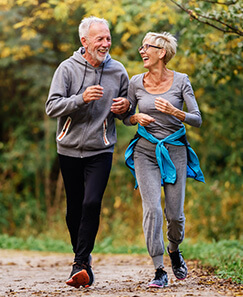Disclaimer: This is a general guideline for exercising. Consult your medical doctor before beginning a new exercise program.
Take a moment to consider just some of the benefits of aerobic exercise: weight control, reduced risk of cardiovascular disease and Type 2 Diabetes, strengthened bones and muscles, improved mood and mental health, and pain reducing mechanisms.1-3 One or more — if not all — of these benefits may be your motivation to getting on the elliptical at the gym, walking around the neighborhood after dinner, or dragging yourself out of bed for a pre-dawn run. Aerobic exercise has “dosing” amounts, measured in time and intensity, to ensure you get the most benefits.
In an effort to direct patients to resources for understanding aerobic exercise, I looked at a lot of reputable websites with information on tracking aerobic output. Although informative and thorough, articles are often long and confusing, as there are several different ways to determine and track your efforts. This article is meant to start with the basics and introduce quick methods to make sure you are getting the most out of your exercise. These basics will include understanding the recommendations, calculating your target heart rate zones, and tracking your heart rate during exercise.
- How much should I do?
The dosing recommendations by the US Department of Health and Human Services are listed in the table below. These recommendations are cumulative-you can do 10 minute chunks throughout the day, as long as you meet the time requirements over the course of the week. Another motivating factor is that it only takes 10 minutes of vigorous intensity exercise or 30 minutes of moderate intensity exercise to activate your body’s natural pain-relieving mechanisms.2
Lengthening the exercise session or increasing the intensity increases the benefits.2,4 Additionally, if weight management is a goal, the more you do and the more intense the activity, the more calories you burn. The table below also shows suggestions for dividing your efforts into manageable sessions. Going all out for 75 minutes on Saturday morning and then being a couch potato the rest of the week isn’t the ideal way to fulfill these recommendations, but that is a conversation for another day.
| Intensity | Times per week (Cumulative) | Dosing suggestions |
|---|---|---|
| Moderate | 150+ minutes | 30+ minutes, 5 days per week |
| Vigorous | 75+ minutes | 25+ minutes, 3 days per week |
- Moderate or Vigorous? How do I know?
Intensity is the level of effort determined by a percentage of your maximum heart rate, which will be 50-85% of your maximum heart rate to meet the definition of “aerobic” or “cardio” exercise. The harder you work, the less time you need to get the benefits. Intensity can be determined by knowing your Heart Rate Zones, as calculated below, or using two subjective self-assessments during activity. If you use the Heart Rate Zones for determining your exercise intensity, there is a little math required. If you are already dreading the “math” part of this article, don’t give up! Skip ahead to the section on the Talk Test and Borg Rating of Perceived Exertion for a math-free way to assess your intensity.
-
Heart Rate Zones — Heart Rate Zones are based off your maximum heart rate (Step 1). There are a few formulas that calculate your heart rate zones, but Step 2 shows you the most basic method.
Step 1: Get your Maximum Heart Rate (HRmax): 220 – your age = ___
Step 2: Use your HRmax to find your heart rate zones:
— Moderate intensity (50-70%) HRmax
— Vigorous intensity (70-85%) HRmax
Step 3: Take your heart rate during aerobic activities and see how it fits into the zones determined above Active heart rate = (count beats in 15 seconds) x 4 If you have a fitness tracker, use the heart rate given but don’t multipl - Subjective self-assessments — Use the table below to see how to best assess for intensity level using the heart rate zones calculated above, or by using the two subjective assessments: Borg Rating of Perceived Exertion (RPE) and the Talk Test.
Borg Rating of Perceived Exertion (RPE)
Use the scale in the table below to rate how hard you feel you are working while you exercise. Why 6-18 and not 1-10? There is a high correlation between the scale below and your heart rate.5 For example, if you are on a brisk walk and you rate your exertion as “13, somewhat hard,” then there is a likelihood that your heart rate at that moment is around 130 beats per minute (Borg, 1998). As you get more experienced with regular exercise and tracking your heart rate, you can use the perceived exertion scale as a quick and easy way to self-monitor.
Try the Talk Test
This self-assessment of intensity is great when exercising with a buddy, as it is based on how well you are able to hold a conversation.1
| Intensity | Heart Rate Zone | RPE | Talk Test |
|---|---|---|---|
| Light | 6 No Exertion 7 Extremely Light 8 9 Very Light 10 11 Light | ||
| Moderate: Breath is quick, but you are not “out of breath”. Light Sweating | 50-70% HR max | 12 13 Somewhat Hard 14 | You can talk but not sing |
| Vigorous: Rapid, deep breathing. Moderate Sweating | 70-85% HR max | 15 Hard (Heavy) 16 17 Very Hard 18 | You have to pause to take a breath every few words |
Wow! That’s a lot of information. Now what?
Now you can get out and get moving! This information may seem heavy at first, but once you get the hang of it, your activities will be much more effective. By working a little harder and tracking your efforts more consistently, you will really start seeing benefits. You may also notice that you are able to do more over time, as one of the principles of exercise is that when you appropriately stress the system, your body adapts work more efficiently under those conditions. Pretty soon, that ½ mile you walk will feel easier, and you will be able to do more with less effort.
Below are some examples of activities based on intensity level.1
| Examples of Moderate Intensity exercise: | Examples of Vigorous Intensity exercise: |
|---|---|
|
|
Really? Pain relieving?
One of the benefits I mentioned earlier in the article is that aerobic exercise activates pain relieving mechanisms. This may seem counterintuitive at first. People who exercise regularly can attest that the first 10 minutes of exercise is often the most difficult. After the first 10 minutes, the brain starts to release “feel good” hormones (endorphins, opioids, and others).6,7 Long term, aerobic exercise also initiates several changes in the nervous system that support improved mood.3,6,7 Even better news: pick an activity you enjoy and those feel good hormones are activated even more!3 When I first start my run in the morning, I often have a lot of signals telling me to stop—I’m out of breath, I have a weird twinge in my knee, and I’m thinking about how comfortable my bed is. Once I get to 10 minutes, there is a noticeable shift. I feel focused … I feel good.
One last word about moving more.
If you are just starting a new exercise routine, it is normal for it to feel difficult or even overwhelming. Exercise works because it appropriately stresses the body. That’s right. Stress on the body can be good because it leads to adaptation of the body’s systems to be able to better handle that activity. Getting out of breath can feel scary, but just remember that it is your body working to meet the needs of your activity. However, if you are dizzy or cannot do the talk test described above, slow down and consult a medical professional to advise you on next steps. When you are first starting a new activity, whether walking more briskly, using the elliptical at the gym, or starting a light jogging program, just remember to start slowly and build up over time. Moreover, find something you enjoy doing and move!
Start your journey to pain-free living today.
Our experts are committed to providing effective, efficient, and compassionate care to help you live a pain-free, active life. Our passion is to help every patient reach their goals on their journey to recovery and optimal performance.


References:
Services USDoHaH. 2008 Physical Activity Guidelines for Americans. In: Services USDoHaH, ed. Vol ODPHP Publication No. U0036. Washington (DC)2008.
Naugle KM, Fillingim RB, Riley JL, 3rd. A meta-analytic review of the hypoalgesic effects of exercise. The journal of pain: official journal of the American Pain Society. 2012;13(12):1139-1150.
Brellenthin AG, Crombie KM, Hillard CJ, Koltyn KF. Endocannabinoid and Mood Responses to Exercise in Adults with Varying Activity Levels. Med Sci Sports Exerc. 2017.
Hoffman MD, Shepanski MA, Ruble SB, Valic Z, Buckwalter JB, Clifford PS. Intensity and duration threshold for aerobic exercise-induced analgesia to pressure pain. Arch Phys Med Rehabil. 2004;85(7):1183-1187.
Borg G. Borg’s perceived exertion and pain scales. Champaign, IL: Human Kinetics; 1998.
Crombie KM, Brellenthin AG, Hillard CJ, Koltyn KF. Endocannabinoid and Opioid System Interactions in Exercise-Induced Hypoalgesia. Pain medicine (Malden, Mass.). 2017.
Koltyn KF, Brellenthin AG, Cook DB, Sehgal N, Hillard C. Mechanisms of exercise-induced hypoalgesia. The journal of pain: official journal of the American Pain Society. 2014;15(12):1294-1304.
